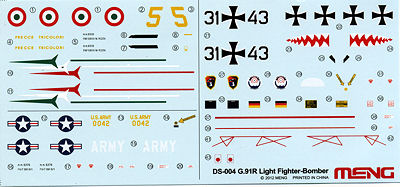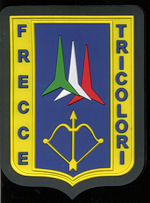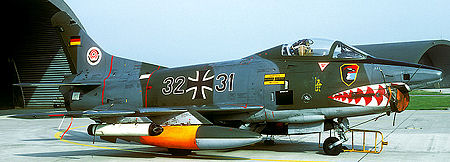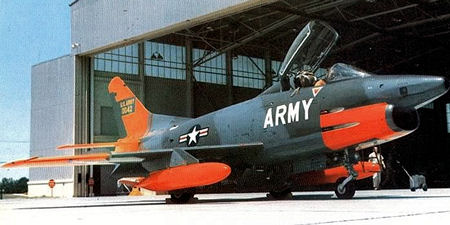
| KIT #: | DS-004 |
| PRICE: | $ |
| DECALS: | Three options |
| REVIEWER: | Scott Van Aken |
| NOTES: | New tool kit |

| HISTORY |
The Fiat G.91 was an Italian jet fighter aircraft. It was the winner of the NATO competition in 1953 as standard equipment for Allied air forces. It entered in operational service with the Italian Air Force in 1961, with the West German Luftwaffe, in 1962, and later with the Portuguese Air Force. It was in production for 19 years. 756 aircraft were completed, including the prototypes and pre-production models. The assembly lines were finally closed in 1977. The Fiat G.91 enjoyed a long service life that extended over 35 years. It was widely used by Portugal in the Portuguese Colonial War in Africa. In addition, both Greece and the US were seriously considering the type, but neither went forward with large purchases. Before the USAF was given control over all Army fixed wing tactical assets, the US Army was seriously considering the type for use as a COIN fighter.
| THE KIT |
 Not an aircraft you would expect to see kitted as a new tool, yet the G.91 has a relatively large and loyal following. !/72 scale modelers have only had the ancient Airfix kit from the 1960s and a rather disappointing one from Revell in the mid 2000s for an injected plastic version, while there was at least one vac/resin kit of the trainer version by Aeroclub.
Not an aircraft you would expect to see kitted as a new tool, yet the G.91 has a relatively large and loyal following. !/72 scale modelers have only had the ancient Airfix kit from the 1960s and a rather disappointing one from Revell in the mid 2000s for an injected plastic version, while there was at least one vac/resin kit of the trainer version by Aeroclub.
Now you can hock your others or give them to the kids as Meng has produced what appears to be the best in this scale yet. If you have seen any of Meng's kits, you are aware of how nicely they are detailed and this one is no exception. The cockpit has nicely raised detail on the instrument panel and side consoles. The seat is pretty generic, but getting an aftermarket version for this aircraft should not be too difficult as it is a variant of the Martin-Baker Mk.4, one of the most widely used second generation seats ever used. Pavla has this in their catalog.
The interior tub sits atop the nose gear well and there is room above it for weight. There is a blanking plate that fits a few mm back from the intake. The instructions would have you paint it silver. I'll paint mine black. To ensure no errors with the intake lip, that piece is separate. The kit offers optional lowered speed brakes. You can also build the kit gear up, though you will have to come up with your own display stand.
Wheel wells have convincing detail and I found the landing gear legs to be OK, though not as detailed as some may wish. The clear bits have a separate canopy and windscreen. It appears you can pose the canopy open, though there is no extension mechanism visible. The aircraft can be built as the German R3 variant with four cannon or the Italian R1 version with two cannon and four machine guns. To accomplish this, there is a large insert that goes on either side of the cockpit.
Since it was a light strike fighter, there are things under wings. For the Frecce Tricolori version you have small tanks for the inner pylons. These are what held the oil for the smoke system. For the other versions, you have two optional wing tanks of different designs. You pick the ones you want. The German planes used tanks that had plates on the end of the fins like on an F-86D/K and those are not included though perhaps you could modify one of the sets. I should also mention that there are two different wing fence designs. One has the outer pylon molded on it while the other does not. For the outer pylon you can put a pair of mk 64 bombs, LAU 51, LAU 32 or lAU 3 rocket launchers.

 Markings options are for three planes. One is the box art plane from the Frecce Tricolori. I had always thought these planes had different nose cones that were pointed and had no cameras. That is true, but they also flew with standard noses,
Markings options are for three planes. One is the box art plane from the Frecce Tricolori. I had always thought these planes had different nose cones that were pointed and had no cameras. That is true, but they also flew with standard noses,  though the cameras were removed and I believe the windows painted over. The second option is for an LekG 43 plane as participated in the 'Bulls Eye '79' meet. This is in standard Luftwaffe colors. The center of the tanks is in da-glo and not regular orange. The third option is most welcome and is one of the planes the US Army was evaluating in 1961/62. Again, the orange listed in the instructions is really da-glo. The decals are superbly printed and should provide no issues. Instructions are in Meng's booklet form and provide a full color fold-out for the markings options. Gunze paints are referenced. A nice option for what is sure to be the first of several boxings, is a full size patch for the Frecce Tricolori. This is a typical patch used by the Italian Airforce and is either leather or a very high quality and thick vinyl. It comes with a velcro backing, ready to be placed on your flight jacket.
though the cameras were removed and I believe the windows painted over. The second option is for an LekG 43 plane as participated in the 'Bulls Eye '79' meet. This is in standard Luftwaffe colors. The center of the tanks is in da-glo and not regular orange. The third option is most welcome and is one of the planes the US Army was evaluating in 1961/62. Again, the orange listed in the instructions is really da-glo. The decals are superbly printed and should provide no issues. Instructions are in Meng's booklet form and provide a full color fold-out for the markings options. Gunze paints are referenced. A nice option for what is sure to be the first of several boxings, is a full size patch for the Frecce Tricolori. This is a typical patch used by the Italian Airforce and is either leather or a very high quality and thick vinyl. It comes with a velcro backing, ready to be placed on your flight jacket.
| CONCLUSIONS |
While perhaps not everyone's favorite aircraft, the G.91 did serve with distinction for decades and it is about time we had a good kit of it in 1/72 scale. Below are two images of aircraft used on this sheet or ones similarly marked. Note that the LekG 43 badge was normally placed on the fin in place of the meet badge.
| REFERENCES |


http://en.wikipedia.org/wiki/Fiat_G.91 January 2013 If you would like your product reviewed fairly and fairly quickly, please contact the editor or see other details in the